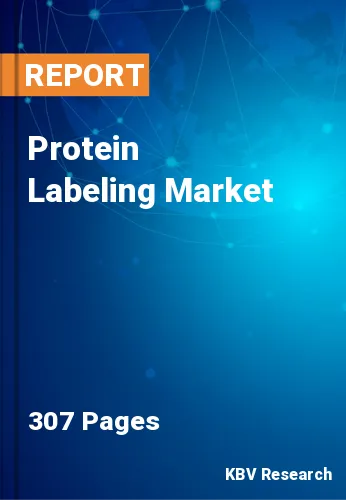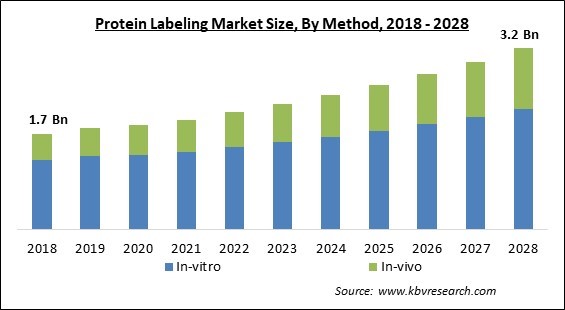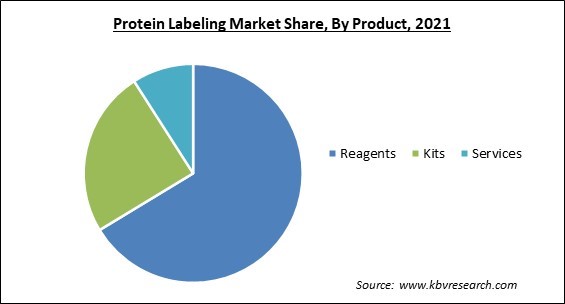
The Global Protein Labeling Market size is expected to reach $3.2 billion by 2028, rising at a market growth of 7.5% CAGR during the forecast period.
Proteins are the biggest macro molecules in a living creature, as they are essential for its survival. In addition, proteins engage with other bio molecules and carry out duties to keep the cell alive once they are created within a cell. As a result, proteomics and protein chemistry is being used to investigate the protein binding mechanism. The majority of these techniques revolve around the ability to create genetic fusions that selectively target proteins, resulting in unique features for selective protein imaging, manipulation, and trapping within complex biochemical settings. To conduct successful protein labeling, a variety of procedures are used.

There is an employment of a variety of methods to label proteins, including the use of specific enzymes or probes. Alkaline phosphatase (AP) and horseradish peroxidase are two often utilized enzyme-protein conjugates (HRP). Enzyme-protein labeling systems have a number of advantages, including signal amplification, a variety of signal outputs, and a wide range of substrates for each enzyme. Fluorescent, chemiluminescent, and colorimetric detection are common signal outputs. These signal outputs are suited for immunohistochemistry (IHC) or immunofluorescent (IF)-based detection applications in cells and tissues because of the wide range of signal outputs.
For examining the function and distribution of proteins in living and fixed cells, the SNAP-tag, CLIP-tag, and ACP-tag/MCP-tag protein labeling technologies provide a new alternative to standard fluorescent proteins. Covalent protein labeling makes imaging mammalian proteins in living cells easier and more versatile, as well as allowing for protein capture in vitro. A fusion protein is created by covalently attaching a single genetic construct to a range of substrates, such as fluorophores, biotin, and beads, to provide a potent tool for investigating proteins.
COVID-19 has quickly expanded in terms of confirmed cases and reported deaths, many countries are among the worst impacted by this pandemic. Owing to lockdowns, travel bans, and business shutdowns, the COVID-19 has had a negative impact on economies and businesses in a number of countries. The closure of various plants and factories has had a severe influence on comprehensive supply chains, negatively affecting manufacturing, delivery schedules, and product sales in the market. A few companies have already stated that there may be delays in product deliveries and a drop in future sales. Moreover, travel prohibitions implemented by countries are harming prospects for commercial cooperation and partnerships.
Healthcare spending can lead to greater health opportunities, which can help to enhance human capital and increase productivity, boosting economic performance. As a result, assessing the phenomena of healthcare spending in a country is critical. Overall, the findings point to a robust link between healthcare spending and economic variables such as income, GDP, and labor productivity. Healthcare spending is positively related to labor productivity, personal spending, and GDP indicators. With more spending by regional governments and healthcare bodies on the enhancement of medical technologies like protein labeling, the method of attaching fluorescent dyes to functional groups in biomolecules such that fluorescence imaging can easily be used to see them.
The ability of health research to contribute to the formation of advanced medical technology like protein labeling accounts for its significant effect. The medical association of various now spends significantly more on research and development (R&D) than other countries, which has been proved to contribute to innovation and the eventual development of a knowledge-based economy. Improving R&D investment is one of those investments that reap a huge reward for the comprehensive industry as it innovates and establishes a knowledge-based economy.

In some region, there is a huge scarcity of skilled professionals, which is hindering the recovery & progress. Along with that, there is a severe issue of unemployment and a lack of chances stymie social cohesion and enhancement. Unemployed or underemployed people may have abilities that are in short supply everywhere. Companies have identified the top three effects of skills shortages as being compelled to hire ill-suited personnel, lost production opportunities, and decreased company investment and product development—all of which hamper companies' ability to compete. Productivity might suffer as a result of a shortage of qualified workers, resulting in longer production times, higher operating costs, and other concerns.
Based on Method, the market is segmented into In-vitro (Enzymatic, Dye-based, Co-translational, Site-specific, Nanoparticle, and Others) and In-vivo (Photoreactive, Radioactive, and Others). The in-vitro segment procured the highest revenue share in the protein labeling market in 2021. The in-vitro labeling method is used to identify the usage of a drug or alcohol from a sample taken from a human body that is not in a live organism, such as a test tube. In vitro, diagnostic medical equipment is tests that are performed on biological samples in order to ascertain a person's health state.
Based on Product, the market is segmented into Reagents, Kits, and Services. The Kit segment acquired a substantial revenue share in the protein labeling market in 2021. The Protein Labeling Kit contains everything required to label an antibody or protein with amine-reactive green-fluorescent Alexa Fluor 488 dye (ex/em 495/519 nm). The kit is designed to label 1 mg of IgG antibody with Alexa Fluor 488 in a single reaction. Other proteins with a molecular weight greater than 20 kDa can also be tagged in modest doses.
Based on Application, the market is segmented into Immunological Techniques, Cell-based Assays, Fluorescence Microscopy, Protein Microarray, and Mass Spectrometry. The immunological techniques witnessed the maximum revenue share in the protein labeling market in 2021. Flow cytometry, immunoassays, western blotting, and immunofluorescence are all examples of immunological methods that use labels. These methods are mostly employed in cancer R&D, autoimmune disease R&D, and pharmaceutical R&D. It is commonly used to identify diabetes, systemic lupus erythematosus, rheumatoid arthritis, lung disorders, neurological disease, and gastrointestinal disease.
| Report Attribute | Details |
|---|---|
| Market size value in 2021 | USD 1.9 Billion |
| Market size forecast in 2028 | USD 3.2 Billion |
| Base Year | 2021 |
| Historical Period | 2018 to 2020 |
| Forecast Period | 2022 to 2028 |
| Revenue Growth Rate | CAGR of 7.5% from 2022 to 2028 |
| Number of Pages | 307 |
| Number of Tables | 570 |
| Report coverage | Market Trends, Revenue Estimation and Forecast, Segmentation Analysis, Regional and Country Breakdown, Companies Strategic Developments, Company Profiling |
| Segments covered | Method, Product, Application, Region |
| Country scope | US, Canada, Mexico, Germany, UK, France, Russia, Spain, Italy, China, Japan, India, South Korea, Singapore, Malaysia, Brazil, Argentina, UAE, Saudi Arabia, South Africa, Nigeria |
| Growth Drivers |
|
| Restraints |
|
Based on Regions, the market is segmented into North America, Europe, Asia Pacific, and Latin America, Middle East & Africa. North America emerged as the leading region in the protein labeling market with the largest revenue share in 2021. The number of immunological techniques, fluorescence microscopy, western blotting, ELISA, and cell-based assays has expanded dramatically in this region. The widespread use of protein tagging techniques in disease diagnosis-related investigations will help the region generate even more cash.
Free Valuable Insights: Global Protein Labeling Market size to reach USD 3.2 Billion by 2028
The market research report covers the analysis of key stake holders of the market. Key companies profiled in the report include Thermo Fisher Scientific, Inc., Merck Group, PerkinElmer, Inc., General Electric (GE) Co., F. Hoffmann-La Roche Ltd., Kaneka Corporation, New England BioLabs Inc., Promega Corporation, LI-COR, Inc., and SeraCare Life Sciences.
By Method
By Product
By Application
By Geography
The global protein labeling market size is expected to reach $3.2 billion by 2028.
Increasing healthcare expenditure to create more health prospects are driving the market in coming years, however, Shortage of skilled and competent professionals limited the growth of the market.
Thermo Fisher Scientific, Inc., Merck Group, PerkinElmer, Inc., General Electric (GE) Co., F. Hoffmann-La Roche Ltd., Kaneka Corporation, New England BioLabs Inc., Promega Corporation, LI-COR, Inc., and SeraCare Life Sciences.
The Reagents segment acquired maximum revenue share in the Global Protein Labeling Market by Product in 2021, thereby, achieving a market value of $2.08 billion by 2028.
The North America market dominated the Global Protein Labeling Market by Region in 2021, and would continue to be a dominant market till 2028; thereby, achieving a market value of $1.29 billion by 2028.
Our team of dedicated experts can provide you with attractive expansion opportunities for your business.
